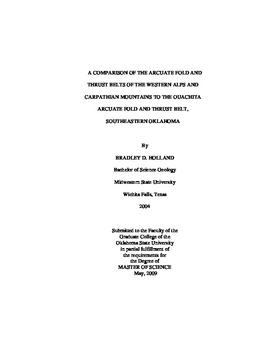| dc.contributor.advisor | Cemen, Ibrahim | |
| dc.contributor.author | Holland, Bradley D. | |
| dc.date.accessioned | 2014-03-14T21:51:25Z | |
| dc.date.available | 2014-03-14T21:51:25Z | |
| dc.date.issued | 2009-05-01 | |
| dc.identifier.uri | https://hdl.handle.net/11244/8023 | |
| dc.description.abstract | The Ouachita Mountains of southeastern Oklahoma contain an arcuate bend, which has been compared to three arcuate bends within the Western Alps (Jura Arc, southern portion of the Western Alps, and the Western Alps, proper) and the Carpathian Mountains. Each of these arcuate bends have been compared using five criteria, which are: 1) orogenic evolution, 2) arc type, 3) fault geometries (map and cross sectional), 4) sedimentology, and 5) gravity profiles (where available). This study investigated several aspects of the Ouachita Mountains that had not previously been defined. Published literature was used to help characterize the geologic evolution and sediment provenance of the Ouachita Mountains, while other components were defined through field investigations and laboratory examinations. As a result of this work, the Ouachita Mountains were found to be the product of a W-directed/Mariana-type subduction zone. Results of this study also indicate that the arcuate bend of the Ouachita Mountains is probably a primary arc, due to the lack of evidence for along-strike shearing that is typically associated with an orocline. Map view fault geometries indicate an oblique collision (~45) occurred during the orogenic process while cross-sectional fault geometries in the research area are similar to adjacent structural cross sections and indicate a W-directed/Mariana-type subduction zone. The gravity profile examined was inconclusive, however, it was indicative a W-directed/Mariana-type subduction zone. The Ouachita arcuate bend most closely compares with the Carpathian Mountains based on the evidence presented in this study. They were both the product of a W-directed/Mariana-type subduction zone and have similar fault geometries. The arcuate bends of the Western Alps do not compare to the Ouachita arcuate bend, however, due to dissimilarities between fault geometries, as well as the fact that the Western Alps are a product of an E-directed/Chilean-type subduction zone. Evidence presented in this study only allows for suggestions to be made but, further research must be conducted before conclusions can be drawn. | |
| dc.format | application/pdf | |
| dc.language | en_US | |
| dc.publisher | Oklahoma State University | |
| dc.rights | Copyright is held by the author who has granted the Oklahoma State University Library the non-exclusive right to share this material in its institutional repository. Contact Digital Library Services at lib-dls@okstate.edu or 405-744-9161 for the permission policy on the use, reproduction or distribution of this material. | |
| dc.title | Comparison of the Arcuate Fold and Thrust Belts of the Western Alps and Carpathian Mountains to the Ouachita Arcuate Fold and Thrust Belt, Southeastern Oklahoma | |
| dc.type | text | |
| dc.contributor.committeeMember | Puckette, Jim | |
| dc.contributor.committeeMember | Boardman, Darwin | |
| osu.filename | Holland_okstate_0664M_10177.pdf | |
| osu.college | Arts and Sciences | |
| osu.accesstype | Open Access | |
| dc.description.department | Boone Pickens School of Geology | |
| dc.type.genre | Thesis | |
| dc.subject.keywords | arcuate bends | |
| dc.subject.keywords | ouachita mountains | |
| dc.subject.keywords | subduction zones | |
| dc.subject.keywords | thrust systems | |
